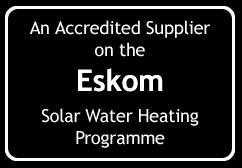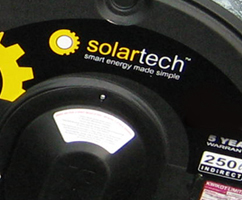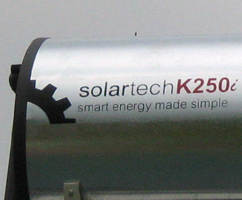

November 25th 2009 The next six months will see a watershed of activity in the solar water heating industry, as role-players gear up to meet the target of rolling out one-million solar water heaters (SWHs) by 2014, which was reaffirmed by Minister of Energy Dipuo Peters, in October, in her medium-term Budget speech. The longer-term target, which is vital in stimulating downstream manufacturing and installation capability, is 50% penetration of SWHs in the residential sector by 2020. The Department of Energy (DoE) will present the final SWH strategic framework to the Minister on December 4, 2009, with the aim of launching and implementing the strategy by April 2010. This came after inputs and written comments on the draft SWH strategic framework – presented to stakeholders at a workshop on November 5 – were received from relevant parties by the November 20 deadline. The draft SWH framework has evolved from an initial workshop with stakeholders in the first half of the year, where the key issues identified were policy targets and support, financing, standards implementation, and manufacturing and supply capacity. Since then, the target of one-million SWHs has been reiterated and, at the most recent workshop, DoE acting deputy director-general for electricity Ompi Aphane explained that the electricity tariff would be the source of funding, although Eskom would not be responsible for managing the funding. “An increase in the electricity tariff to support the roll-out of SWH’s is far more justifiable than the significantly greater increase required for covering the capital cost of even more coal power. Not only are solar geysers a more cost-effective, environmentally responsible and job-intensive means to bridge the electricity supply-demand gap, it also gives us breathing space to delay or even defer costly projects like Kusile,” says World Wide Fund for Nature (WWF) South Africa trade and investment adviser Peet du Plooy. The workshop also unearthed acknowledgements that the Eskom rebate for SWHs did not have the desired effect in stimulating the uptake of units in the South African market, hence the need for more strategic and coordinated plans. Stakeholders complained of chronic late payments from the utility when it was in charge of the subsidy scheme. Based on current initiatives and industry levels, it would take more than 15 years to reach the one-million-SWHs target, or 75 years to reach 50% market penetration – hence, the need for increased impetus and robust supporting frameworks. The recently presented draft framework “is a complete shift from a fragmented low-volume high-cost industry to a coordinated utility mass roll-out paradigm”, explains Development Bank of Southern Africa renewable-energy market transformation project coordinator Yaw Afrane-Okese. NATIONAL SWH ENTITY The draft framework recommends the creation of a national SWH entity, under the Public Finance Management Act (PFMA), to enact national SWH policy as well as funding arrangements, and orchestrate the delivery to currently unserviced residential market sectors. The entity will be a single point of account- ability for stakeholders in achieving the national SWH plan in defined market sectors. It will need to be clearly defined to ensure that its establishment takes place within the short period of time defined. A public SWH delivery entity at national level will be accountable to three sets of stakeholders, namely investors, the licensing authorities and the consumer. It will serve specifically defined market sectors, particularly those not currently benefiting from the roll-out of SWHs. It will best serve the interests of low- and middle-income householders and ensure effective orchestration of bulk buying, highly affordable systems, skills training, deployment of private- sector subcontractors, and that subsidies reach households. It is also viewed as important that the utility has the right to obtain and allocate revenue from carbon offsets, demand-side management (DSM) and other revenue streams to achieve the national SWH plan. Energy solutions company Unlimited Energy director Duncan Abel explains, “Carbon funding is not the silver bullet that will drive the mass roll-out of SWHs, but it is an important component of a coordinated national roll-out to be driven by both government and the private sector.” The key aims of the national entity are to ensure affordability by procuring low-cost, best-quality systems through bulk buying and large contracts with quality assurance; to obtain and manage funding streams; to rigorously manage the supply chain; to ensure large-scale project management and disciplined deployment of numerous subcontractors; to protect consumer rights and interests in terms of events such as flooding or repairs; and to be accountable to government, funding bodies and consumers. FUNDING CONCERNS Responsible for presenting the draft framework at the workshop on November 5, Afrane-Okese says that, despite a few concerns being raised by stakeholders, the framework has been well received. The concerns flagged were the funding model, particularly considering past experiences with Eskom in charge of the subsidy scheme; complicated monitoring and verification; and the need to ensure local manufacturing as part of the mass roll-out programme. Afrane-Okese adds that final agreements on the business case and funding streams are in process, although a basic approach has been outlined. Minimal National Treasury support will be required, and it is hoped that the large-scale roll-out will reduce costs. The framework states that the national SWH entity will need to be a self-sustaining one, with individual programmes to ensure that costs equal income, and that cash flow funding will fill the gap between the timing of expenditure and subsidy income. This basic approach includes self-funding programmes, where costs could be covered by a subsidy plus a customer contribution. Prices will also be ‘stepped’ to be highest level for upper-income homes and to the lowest level for poor households, with a new entity to deliver to the middle- and low-income market. Primary sources of funding will be the standard offer based on electricity savings; programmatic Clean Development Mechanism funding, which will be centrally coordinated to ensure adequate scale; and other small funding components, such as support for the indigent. In terms of funding for local manufacture, the national SWH entity will turn to the Department of Trade and Industry (DTI) to provide incentives. Also, initiatives such as the one recently announced by the Department of Environ-mental Affairs – a $500-million ‘infusion’ through the Clean Technology Fund (CTF), which sought to scale up grid-connected renewable energy, SWHs and energy efficiency – will play a role. Environmental affairs director-general Joanne Yawitch explains to Engineering News that the fund will support the roll-out of SWHs as it will provide lines of credit for local banks to stimulate manufacture and installation capacity, making it easier for the private sector to access funds for clean technology investment. The CTF is part of the Climate Investment Funds, being implemented in South Africa jointly by the African Development Bank, the International Finance Corporation and the World Bank. UNIVERSAL ACCESS Sustainable Energy Society of South Africa SWH division chairperson Dylan Tudor-Jones explains that the current geyser market is about 400 000 units a year, which excludes old housing stock and low-income housing. Providing universal access to modern, affordable and environmentally beneficial SWH services for all households in South Africa on an equitable basis is a key focus of the strategic framework. The programme hopes to stimulate accelerated water heating service delivery, particularly to low-income and indigent households by using renew-able-energy sources. The programme is seg-mented by a total of six emerging major market groupings – each requiring different solutions. These are first-tier or upper-income residential retrofits of existing electrical geysers; second-tier or middle- to low-income electrical geyser retrofits; third-tier residential retrofits or delivery of SWHs to homes with no existing geyser; fourthly, new-build homes, both upper- and middle-income homes and affordable housing; the fifth level replacing failed electrical geysers; and, finally, industrial and commercial SWH systems in both the public and private sectors. Different approaches for each of the six divisions have been put forward. MUST-HAVES TO MEET TARGETS A number of supporting activities will need to take place to ensure targets are met. Key policy interventions required are an integrated national SWH policy from govern- ment; target setting by Cabinet with non- negotiable delivery; mandating of the national utility; and role clarity between shareholders, Ministers and providers. Regulatory and legal matters to be taken care of include setting up the national SWH entity under the PFMA; the drawing up of SWH market rules by the National Energy Regulator of South Africa; national building codes and regulations alignment, as well as appointing local authority building inspectorates for SWH approvals and bylaws; and new-build and refurbishment geyser replacement legislation. To create a sustainable SWH market, DTI inward investment will be required to boost local manufacture through fiscal investment incentives. The national SWH entity procurement will also need to include an increasing locally manufactured uptake clause. Skills development, training and capacity building are also important to ensure the meeting of the targets. The Department of Labour will be responsible for skills training facilitation and accreditation, and large installation contractors will be required to undertake certain training responsibilities. An increase in support to entrepreneurs will also be necessary, and the existing SWH industry will need to support upper-income training initiatives. TIGHT TIMELINES It is envisaged that, by the end of January 2010, a detailed implementation plan will be complete, as well as standards and moni- toring and verification protocols finalised, and, in February, the Minister will issue a section 34 determination, or integrated resource plan, and set the target of one-million SWHs by 2014. By the end of March, a national energy services company or body will be clarified. Once launched in April, manufacturing tendering will go out, with the national body inviting tenders under an independent system operator, and covering implementation, marketing, sourcing, installations, maintenance, financing and so on. Installation of the units in targeted areas will continue with greater focus on local manufacture. The target to be reached by 2014 is one-million SWHs and, by 2020, it is hoped that a further four-million units will be rolled out. There is certainly much work to be done in a short space of time; however, Peters has reiterated that, considering market penetration potential and the enthusiasm of industry players, the target is “easily attainable” and, in fact, the industry could do more to exceed the target. WWF SA has commended the launch of the draft framework, which, it says, sets the groundwork for the roll-out of the programme; however, the organisation adds that increased urgency and action are needed if the programme is to realise its full potential for improving energy security and unlocking jobs and industrial growth.
|


